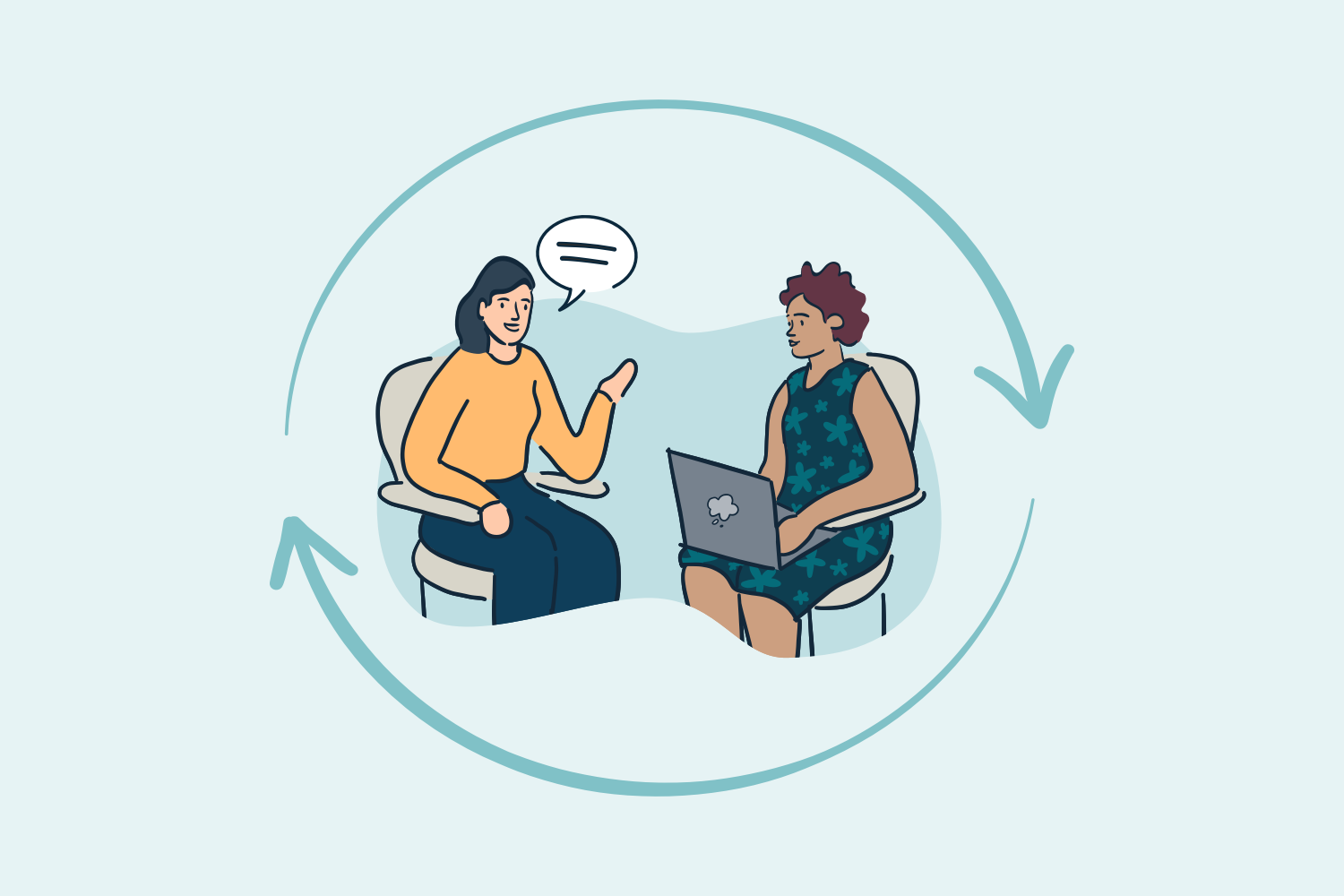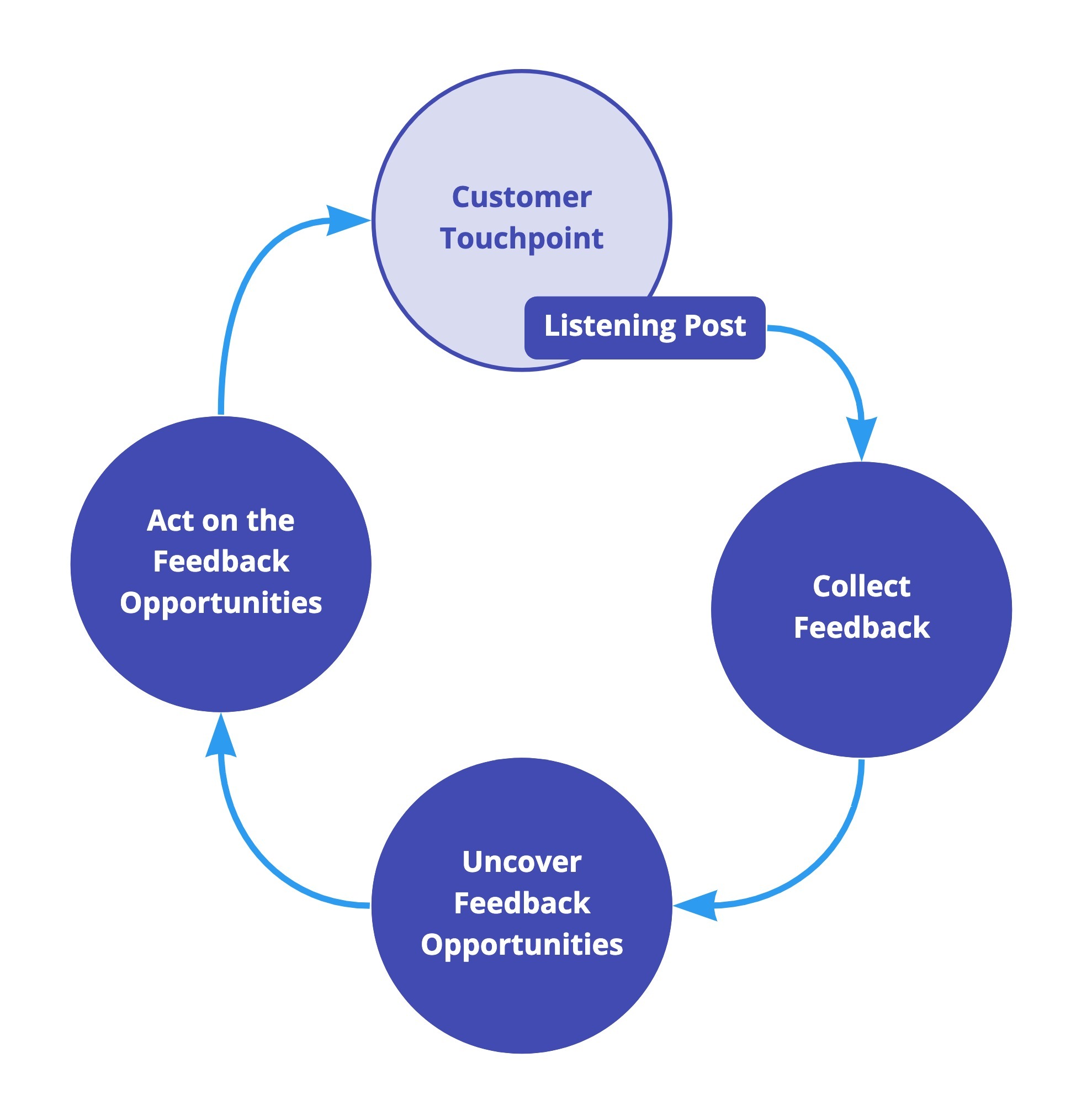
In today’s digital-first world, our customers are used to and expect easy-to-use, seamless digital experiences. If you’re not providing the experiences they expect, they’ll find someone who does. You can stay ahead of the competition by listening to your customer’s needs, wants, and pain points and delivering modern, intuitive solutions.
Customer feedback loops are effective and vital to improving your digital products and experiences. In this post, we’ll dive into what a customer feedback loop is, the types of customer feedback loops, their importance in your product design and development, how to set one up, and how to close the loop and provide customers with the experiences they need and expect.
What is a customer feedback loop?
A customer feedback loop provides businesses with a system to collect feedback from customers and follow up meaningfully. This followup involves using the feedback to identify customer experience opportunities, taking action on those opportunities, and reconnecting with customers about the resulting improvements and updates.
At a high level, a customer feedback loop is made up of two parts: the feedback and the loop.
Feedback in itself can take many forms, but overall, it’s a moment in which you ask for input from your customers or employees. Easy.
The loop, however, requires more explanation. The loop starts with the feedback points, or what we call listening posts. Listening posts capture feedback data from your customers about their experiences. This data provides insight into the customer experience—what’s working well and opportunities for improvement. The feedback loop is complete when action is taken and customers observe change.
Types of customer feedback loops
There are two types of feedback loops that can be used to garner information from users of your products or services. These are internal and external feedback loops, or employee feedback loops and customer feedback looks. It’s important to note that your users on both ends of the system are impacted by its experience and you can glean valuable information from both sides.
Internal feedback loops
An internal feedback loop, sometimes referred to as a “positive feedback loop” is when your company requests feedback from its employees. This can be done formally through in-depth interviews and surveys, or more informally through virtual (or physical) suggestion boxes—but it should be a direct ask. The goal here is to improve any internal processes, infrastructure, and tools to lower employee turnover.
External feedback loops
External feedback loops, which can also be referred to as a “negative feedback loop” is when you request feedback from your customers, usually in the form of pain points or things that need to be improved. This feedback is then used to improve your digital experiences and products, with the end goal being to improve the customer’s experience, create loyalty, and increase revenue.
Importance of customer feedback loops
Implementing a feedback loop should be driven by the desire to have customer input influence business and design decisions.
Customer feedback is about much more than just collecting the feedback—it’s about gathering feedback with purpose and fully understanding the customer experience. This understanding of the customer experience will help to prioritize where you might evolve your customer experience and provide you with guiding feedback as you introduce new features or offerings, supporting your design process.
Reap the benefits of adopting customer feedback loops
There are many reasons you should listen to your customers—that seems obvious— but a few benefits we’ve seen come from customer feedback loops are:
-
- Improving the customer experience increases customer loyalty. By listening to your customers’ complaints and pain points and addressing them in a timely manner, you’re setting your organization up for success.
- Reduce customer churn with iterative improvements. If you make small updates to improve the platform and address customer concerns, they’re less likely to seek other products or services. Take their advice and improve the widget, adjust the form layout so it’s easier to enter content, or change the navigation to make top-level content accessible.
Ready to improve your customer experience?
Our team of experts can help you uncover their paint points.
- Improved employee experience means less employee turnover. Whether you’re implementing internal feedback loops and addressing process issues from your employees, or improving and fixing pain points your customers share, you’re likely setting your employees up for more success.
- Better customer support makes for better internal morale. To add to the improved employee experience, if you provide your customers with the experiences they need, you’re likely lowering the customer service complaints and creating a lighter load for your employees.
- Feedback means continued growth and improvements. If you take the time to listen to your users and implement changes to your digital products and experiences iteratively, you’ll consistently be on the path toward success. Ensuring your products don’t stay stagnant and regularly modernizing will keep you at the front of the pack.
How to create a customer feedback loop
As we’ve reflected on a recent project in which we created a customer feedback strategy with a client, we have captured key steps for setting up a customer feedback loop. So, as you think about building a customer feedback loop, be sure to consider the following.
1. Set feedback goals
Clarify what you hope to learn to give your feedback purpose, help frame questions, and get you thinking about how you will use the feedback. Weak feedback goals are vague and broad. For example, “Get customer input on the onboarding process” is not a good enough reason to collect feedback. It’s difficult to ask questions that line up to this goal, and results may include a wide range of responses to one question. Try to dig a bit deeper; what specifically about the signup process do you want to know more about, and why?
Strong feedback goals tie directly to something actionable. For example, “Understand how customers perceive their effort during the onboarding process” is more focused and will point to opportunity areas to reduce customer effort during onboarding. With more specific goals comes more purposeful listening posts and a clearer direction for changes.
Within this stage, you should also consider how often you are asking customers for input and where you may be able to make cuts. Think about what each listening post will bring and compare that to your own business goals. Which points will give input you need now? You can also consider where you might be able to complement the feedback with other available data such as usage analytics or customer service feedback.
2. Choose the touchpoints to focus on to meet your feedback goals
Well framed goals will make it easier to choose the right time to ask for feedback. Take the time to align goals with relevant points in the customer experience—highlighting the best touchpoints to ask and answer each question you may have. For example, if you want to learn about effort in the onboarding process, choose the interactions that often involve high customer input. This might include any in-person transactions, any complex digital platforms to set up, or anything that spans long time periods. In our example, asking about effort right after these kinds of interactions is best, when experiences are fresh, instead of waiting until the end of the entire onboarding process.
If you don’t collect feedback today, just start with the customer touchpoints. It helps to create a touchpoint map like the one shown here, visualizing the customer processes and key interactions they have with you.
3. Define the feedback governance
Maintaining a customer feedback loop requires ownership and planning. This is probably the most important part. Without it, your feedback won’t continue smoothly over time. Determine who should be involved, when, and to what extent. Overall, we recommend breaking the operationalization of a customer feedback loop into three main parts—the listening posts, the data, and closing the loop.
- Assign an owner of the listening posts. In order to keep consistency and reduce duplicity across the feedback landscape, someone (or a group) should own where and how feedback is collected from customers. This will reduce duplicate feedback requests of your customers and help you keep your touchpoint map up to date.
- Assign an owner to the feedback data. Collecting feedback means collecting data. This data needs a place to live, a way to be analyzed and a way to be shared. Set a schedule for when data will be assessed and synthesized. Share feedback insights with those whose efforts or roles may be impacted. Consider customer service teams, product design teams, executive decision makers—the right people need to know what changes need to occur.
- Assign an owner to closing the loop. How and when you close the loop with customers will vary. Each listening post, and sometimes even each type of response, should be considered for closing the loop possibilities. Having someone own the response protocol and process is invaluable.
4. Gather user feedback
There are many ways you can gather customer feedback effectively with user feedback loops. Here are a few ways we’ve found successful:
- Employee and customer satisfaction surveys
- Net Promoter Score surveys
- Gather information from your CRM, customer support systems, chatbots, etc.
- Pull reviews from review sites
- Utilize social media listening tools
Whether you’re setting up structured surveys, analyzing data from CRMs and your website, or looking to outside sources for reviews and sentiment, it’s important you do so regularly.
5. Analyze the user feedback
So, you have gathered the feedback from some of the above sources we mentioned, now what? It’s important that during this stage researchers are looking for patterns and common pain points. Many of the tools you’re in will synthesize data into dashboard insights, but we like to take that data and work through exercises to group commonalities and rank those by largest pain point to smallest, and biggest lift, to lowest. This allows our team to set priorities and create a roadmap for these improvements.
A quick win might go a long way to show your customers that you’re listening!
6. Decide how you’ll close the loop with customers and take action
This means thinking about how your customer will know their feedback is valued, and continue to give it. People are more inclined to give feedback when they understand where that feedback is going. Give customers a glimpse into why their feedback is particularly helpful and how it will make their experience better in the future. The way in which you respond to customer feedback should consider the time the customer put into responding and the tone of their response. For example, specifically frustrated responses might warrant a direct follow-up. Some ideas on how you might close the loop with your customers:
- Give insight into the purpose of a survey before they begin, especially long-format surveys. Make it worth their time.
- Always be sure to thank customers for their participation and give some insight on what will happen now that they’ve shared information—i.e., a new feature is being worked on, a new feature will be launched soon, a new product is in the works.
- Communicate at large, to all your customers, a summary of what feedback you’ve heard over the year and how or if you’ve implemented change because of it.
- Actually act on the feedback. Making changes based on feedback will resonate with customers. Experiencing improvements related to feedback is the best way a customer can feel heard.
Improve your customer’s experience with feedback loops
As with most things, a customer feedback loop takes time to cultivate. It’s not about perfecting this model, it’s about creating starting points for connecting and listening to customers. Remember to be realistic about your capabilities when setting up the loop. Take time to think through these considerations and be open to iteration—in how you collect feedback, how you assess the feedback data, and how you close your loop. After all, this process is about growing, evolving, and learning new things for better outcomes.
If you’re looking to improve your digital products and experiences, our team of experts can help. Let’s chat.




